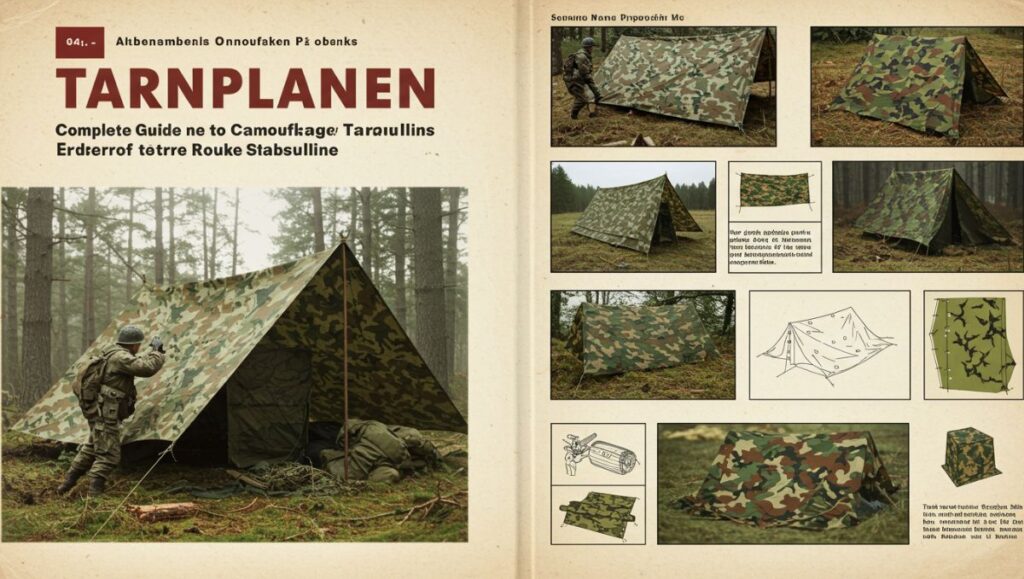In outdoor activities, military operations, or even industrial settings, the right protective covering can make a significant difference. One of the most versatile and effective tools in this category is the Tarnplane (plural: Tarnplanen). These camouflage tarpaulins combine practical protection with the ability to blend into natural surroundings, making them a favorite for soldiers, hunters, survivalists, campers, and outdoor workers.
This guide explores everything you need to know about Tarnplanen—from their history and construction to their many applications in daily life.
What Are Tarnplanen?
A Tarnplane is a tarpaulin (durable waterproof sheet) printed with camouflage patterns. Unlike standard tarps, which are usually plain green, blue, or transparent, Tarnplanen are specifically designed to conceal objects, shelters, or people in natural or tactical environments.
They are typically made from:
-
Polyethylene (PE) – lightweight, affordable, waterproof.
-
Polyvinyl chloride (PVC) – heavy-duty, flexible, long-lasting.
-
Canvas – breathable, sturdy, often used for military-grade tarps.
The surface is coated or laminated for UV resistance, tear resistance, and weather protection, making Tarnplanen reliable even in harsh environments.
History of Tarnplanen
The concept of camouflage tarpaulins has roots in the military. As camouflage techniques developed in the 20th century, armies realized the importance of covering vehicles, equipment, and supplies in a way that blended with forests, deserts, or snow.
Over time, civilian uses emerged. Campers, hunters, and outdoor enthusiasts discovered Tarnplanen to be perfect for concealment, protection, and survival. Today, they are widely available for both professional and recreational use.
Key Features of Tarnplanen
1. Camouflage Patterns
The most defining feature of Tarnplanen is their print design. Popular patterns include:
-
Woodland camouflage – brown, green, and black for forests.
-
Digital camo – pixelated designs for tactical use.
-
Desert camo – beige and tan for sandy environments.
-
Snow camo – white and grey for winter landscapes.
2. Durability
Made to withstand rain, wind, and UV radiation, Tarnplanen are stronger than many standard tarps. Reinforced corners and rustproof grommets allow for secure fastening.
3. Waterproofing
Most Tarnplanen are 100% waterproof, keeping shelters dry during heavy rain.
4. Versatility
They can be used as shelters, covers, ground mats, tents, or even makeshift boats in survival situations.
Applications of Tarnplanen
1. Military and Tactical Use
-
Concealing vehicles, weapons, and supplies.
-
Building temporary shelters in combat zones.
-
Reducing visibility from drones and satellites.
2. Camping and Outdoor Activities
-
Lightweight tarps for tents or hammocks.
-
Groundsheet protection under sleeping bags.
-
Rain covers for gear and firewood.
3. Hunting and Wildlife Observation
-
Blinds and hides for hunters.
-
Concealing observation posts.
-
Reducing human presence in sensitive areas.
4. Survival and Emergency Preparedness
-
Makeshift shelters in emergencies.
-
Water collection in survival scenarios.
-
Reflective insulation when combined with thermal blankets.
5. Industrial and Civilian Use
-
Covering construction materials.
-
Protecting vehicles and boats.
-
Outdoor storage concealment.
Advantages of Tarnplanen
-
Blending into surroundings – perfect for outdoor concealment.
-
Durable and long-lasting – resistant to tearing and weather.
-
Portable – lightweight and foldable for easy transport.
-
Multi-purpose – works as shelter, groundsheet, or cover.
-
Affordable – available in many price ranges.
Choosing the Right Tarnplane
When selecting a Tarnplane, consider the following factors:
-
Material – For lightweight use, choose PE; for heavy-duty applications, choose PVC or canvas.
-
Size – Smaller tarps work for gear; larger ones for shelters or vehicles.
-
Camouflage Pattern – Select a design that matches your environment (forest, desert, snow).
-
Weight – Heavier tarps provide more durability but are less portable.
-
Waterproofing – Ensure the tarp is fully waterproof, not just water-resistant.
Maintenance and Care of Tarnplanen
To maximize the lifespan of a Tarnplane:
-
Clean regularly with mild soap and water.
-
Avoid sharp objects that can puncture the fabric.
-
Store dry to prevent mold and mildew.
-
Inspect grommets and seams before each use.
With proper care, a good-quality Tarnplane can last for years.
Sustainability and Eco-Friendly Options
As awareness of environmental issues grows, many manufacturers now produce eco-friendly Tarnplanen using:
-
Recycled materials.
-
Non-toxic dyes for camouflage patterns.
-
Biodegradable coatings.
These options reduce environmental impact without sacrificing durability.
The Future of Tarnplanen
The demand for Tarnplanen is expected to grow as interest in outdoor lifestyles, survivalism, and military-grade gear continues. Future trends may include:
-
Smart fabrics with infrared-blocking properties.
-
Lighter, stronger materials using nanotechnology.
-
Eco-friendly camouflage designs with natural dyes.
-
Multi-purpose designs combining tarp, tent, and poncho functions.
Conclusion
Tarnplanen are more than just tarps—they are tools for survival, protection, and concealment. Whether you are a soldier, camper, hunter, or outdoor enthusiast, Tarnplanen provide durability, camouflage, and versatility that standard tarps cannot match.
From protecting gear in the rain to blending into the wilderness, Tarnplanen prove that the final layer of protection can often be the most important.
If you are planning your next outdoor adventure or want reliable emergency gear, investing in a high-quality Tarnplane is a decision you won’t regret.






